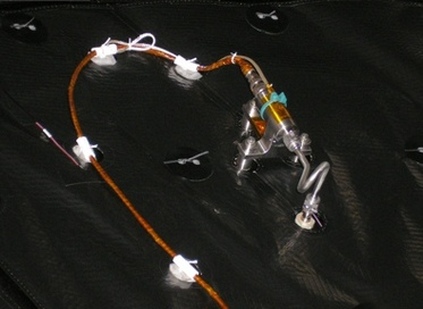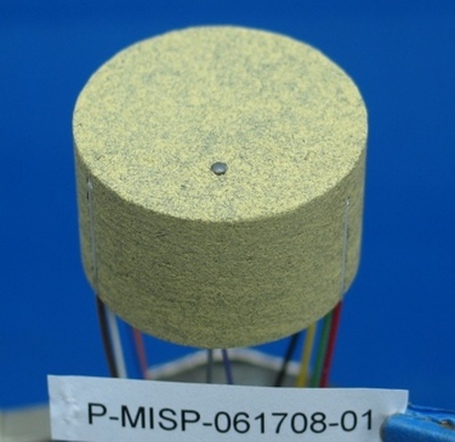MEDLI – MSL EDL Instrument Suite

The MSL EDL (Entry, Decent and Landing) Instrument suite is a set of engineering sensors and electronics to measure atmospheric properties and heat shield performance during the crucial Entry and Landing Phase of the MSL Mission. It is not a part of the core science payload of MSL. Its goals are to provide information to help the improvement of systems that will be used on future planetary missions. MEDLI was designed, developed and built by NASA’s Langley Research Center and NASA Ames Research Center.
MEDLI includes 7 MEDLI Integrated Sensor Plugs (MISPs) and 7 Mars Atmospheric Data System (MEADS) Pressure Sensors that are installed on the heat shield of the spacecraft. Inside the heat shield and not exposed to the entry environment is the Sensor Support Electronics (SSE) Unit. It provides power, signal conditioning and signal conversion for digital processing. Data acquisition is initiated when the entry system separated from the spacecraft bus approximately 10 minutes prior to entry. It will be taking data at a frequency of 8 Hz until after the main chute is deployed about two minutes after entry interface. A portion of MEDLI data will be included in the real time telemetry stream during the entry phase. The full data set that is collected is sent to the Rover Compute Element for storage and downlink. It is expected that the complete data collection will be downliked during the first month of landed operations should downlink time be available.

Each MISP plug consists of four type-K thermocouplers that are installed at different depths in the Thermal Protection Material of the Heat Shield to measure the heat profile inside the TPS. The couplers are installed at depths of 0.1, 0.2, 0.45 and 0.7 inches. These instruments measure the temperature of the TPS as a function of time during entry. Each plug also contains a single Hollow Aerothermal Ablation and Temperature (HEAT) Sensor. This particular sensor measures the propagation of a single isotherm through the material. Data of both instrument types will provide an exact history of the performance of the MSL TPS. The nominal data frequency is 8Hz, but some sensors will gather data at 2Hz. HEAT will also determine a loss in surface material due to ablation as a function of time during entry. The MISP plugs are concentrated in the area of the highest thermal loads due to turbulent air flow. 1.30 inches in diameter, the plugs are enclosed in the same material that is utilized on the TPS and inserted into 1.31-inch holes in the heat shield. Smaller holes are drilled through the aeroshell structure to direct the wires of the plugs to the SSE. The seven MEADS sensors include a pressure sensor that is installed on the interior of the heat shield. A small 0.1-inch hole is drilled through the TPS to allow accurate surface pressure readings. These holes will not impact TPS performance during entry. MEADS sensors form a cross pattern in the low-heating – high pressure portion of the aeroshell. This pattern will enable scientists to deduce exact vehicle orientation data from comparing MEADS data to predicted values.
SSE on Vibration Isolators

Objectives
It is anticipated that MSL will enter the Martian Atmosphere at a velocity of 6.1m/s. In combination with its size and mass, the air flow around the vehicle will become turbulent fairly early into re-entry. Heat flux and shear stress on the Thermal Protection System will be greater than on any previous Mars Mission. Uncertainties in simulations prompted large margins in the design of MSL’s heat shield at the cost of mass and science payloads. Reducing these margins for future missions requires more accurate simulations based on actual data obtained in the entry environment. MEDLI will provide data concerned with atmospheric properties and heat shield performance that will be compared with pre-flight predictions to evaluate the level of uncertainty and the margins used for this mission. MEDLI’s data collection will be the largest set of data acquired in a non-Earth Entry. Inertial Measurement Unit Data of the entry phase will be combined with MEDLI information to provide data on surface pressure distribution, vehicle attitude, dynamic pressure on the structure, Velocity, and the atmospheric density and winds. With MEDLI data, peak heat flux, distribution of heating on the heat shield, map transition to turbulence, and TPS performance will be acquired.
